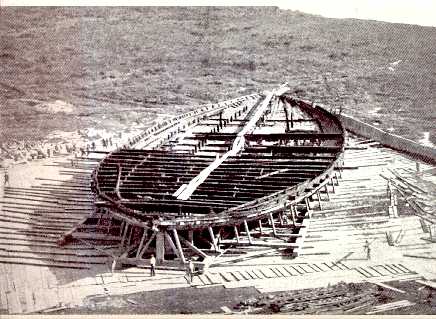

Located in Lake Nemi in Italy, the Nemi ships consisted of two vessels built on orders of the Roman emperor Caligula (37 to 41 AD) known for his extravagant lifestyle.
The ships served as floating palaces, complete with intricate decorations, marble floors, and elaborate plumbing systems.
They demonstrated advanced Roman engineering techniques, including the use of waterproof concrete, complex hull designs, and innovative plumbing systems. They had features like heated baths and were adorned with exquisite artwork, including mosaics, marble statues, and bronze decorations.

The Nemi ships were impressively large for their time. The first Ship called Prima Nave had a length of approximately 70 meters (230 feet) and a width of about 20 meters (66 feet). The second called Seconda Nave was 73 meters (240 feet) long and 24 meters (79 feet) wide.

Both ships were constructed with high-quality materials, including oak and pine wood, and featured advanced techniques such as waterproofing with lead sheeting and bitumen.
The sheer size and opulence of the ships reflected the grandeur and the luxurious lifestyle associated with Emperor Caligula. They were likely used for leisure and ceremonial purposes, showcasing the emperor’s wealth and the technological advancement of the Roman Empire.
The ships were discovered in the 15th century, but serious attempts to recover them only began in the late 19th and early 20th centuries. Italian dictator Benito Mussolini ordered the draining of Lake Nemi in the 1930s, leading to their successful recovery.

The Nemi ships were destroyed in the final stages of World War II. On the night of May 31, 1944, a fire broke out in the Museum of Roman Ships at Lake Nemi, where the ships were housed. The fire caused extensive damage, destroying much of the wooden structures and artifacts. Most of the ships were lost to the flames.
The exact cause of the fire remains disputed. One theory suggests that retreating German forces set the museum ablaze to prevent advancing Allied troops from capturing the ships and the valuable artifacts. Another theory posits that the fire resulted from Allied bombing in the area, although there is less evidence to support this.
A third theory considers the possibility of an accidental fire, possibly caused by negligence or mishandling of flammable materials during the chaotic war period.
The remains of the Nemi ships, along with related artifacts and replicas, are housed in the Museo delle Navi Romane (Museum of Roman Ships) located near Lake Nemi in Italy.
Despite the destruction, some metal and stone artifacts survived the fire. These remnants, along with photographs and drawings made before the fire, have allowed historians and archaeologists to reconstruct aspects of the ships.
Related: Stunning Ancient Marble Bust Found at the Bottom of Italian Lake
